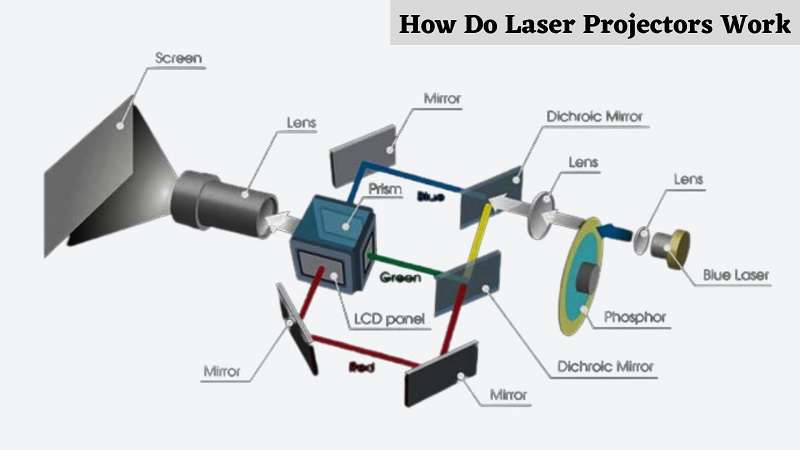In the realm of visual wizardry, How do Laser Projectors Work is a question that captures the curiosity of many. We’re all mesmerized by the vibrant, ultra-defined images from our projectors, but what’s the secret? Ever wondered about the magic happening inside a short-throw laser projector as it brings life to an entire wall from just inches away?
Or pondered the intricacies that enable an Epson laser projector to captivate audiences with its riveting color performance? And who isn’t awestruck by the stunning precision of a 4K laser projector, painting each pixel with meticulous accuracy? Welcome aboard as we embark on a journey to unravel these enigmas of the projection world!
Basic Principles of Lasers
Lasers, short for “Light Amplification by Stimulated Emission of Radiation”, are a technology born from the fascinating realm of quantum mechanics. This concept involves stimulating atoms to release photons, creating a monochromatic light beam of a single wavelength. The unique properties of this light, such as coherence and intensity, make it a versatile tool in various applications.
How Do Laser Projectors Work

Laser projectors take advantage of this laser light, splitting it into three primary colors: red, green, and blue. By varying the intensity of each color, a laser projector can produce a full spectrum of colors. The colors are then focused onto a DLP chip or LCOS chip, which creates the image. These images are subsequently beamed onto a screen, resulting in the bright, crisp visuals we see.
Key Components of a Laser Projector
Central to a laser projector are the lasers themselves, typically diode lasers, which generate the light. Next is the light source module, which separates the laser light into the three primary colors. The optical engine follows, including a DLP or LCOS chip, responsible for creating the image from the colored light. Lastly, the lens projects the image onto the viewing screen.
You may like ELPLP76 Replacement Lamp: The Ultimate Guide To Fix Fading Images
Differences Between Laser and Traditional Projectors
Laser projectors differ from traditional projectors primarily in their light source. Traditional projectors use lamps that offer limited lifespan and gradually decrease in brightness. In contrast, laser 4k projectors provide consistent brightness throughout their extended lifespan. Moreover, laser projectors deliver superior color range, contrast ratio, and image quality.
Benefits of Laser Projectors
Laser projectors boast several significant advantages. They provide outstanding image quality with vibrant, true-to-life colors. The long lifespan of lasers translates into lower maintenance costs and less downtime. Additionally, they offer flexibility with installation, given their capacity for short-throw projection and 360-degree positioning.
Common Uses of Laser Projectors
Laser projectors have found a home in various sectors, from home theaters and gaming setups to professional settings like boardrooms and classrooms. Due to their high brightness levels, they are also suitable for large venues like movie theaters, concerts, and outdoor events.
You may also like How Epson Projector Management Software Enhances Your Setup
FAQ About how do laser projectors work
What is a laser projector?
A laser projector is a device that uses lasers as a light source to project high-quality images onto a screen.
How does a laser projector work?
It works by splitting a laser beam into three primary colors, modulating each color’s intensity, creating an image with the colored light, and projecting this image onto a screen.
What are the key components of a laser projector?
The key components include the diode lasers, light source module, optical engine (containing a DLP or LCOS chip), and the lens.
How does a laser projector differ from traditional projectors?
Laser projectors offer more consistent brightness, extended lifespan, superior color range, and improved image quality compared to traditional projectors.
What are the benefits of using a laser projector?
They offer superior image quality, lower maintenance costs, longevity, and flexible installation options.
What applications are laser projectors commonly used for?
They are commonly used in home theaters, gaming setups, professional settings, and large venues like theaters and outdoor events.
How is the image quality in a laser projector?
The image quality is superior, offering vibrant, true-to-life colors with high contrast ratios.
What makes laser projectors a better choice for high brightness needs?
Their ability to maintain consistent brightness over time makes them a better choice for high brightness needs.
How do I maintain a laser projector?
Maintenance involves cleaning the outer casing and lens, ensuring adequate ventilation, and regularly checking for software updates.
What is the future of laser projector technology?
The future holds brighter, more efficient lasers, improved image processing technologies, and potentially smaller, more portable units.
Conclusion
Laser projectors, with their many benefits, are quickly becoming the standard for high-quality, reliable, and flexible projection solutions. Understanding their functioning gives us a newfound appreciation for the brilliance of this technology, making our viewing experiences more enjoyable and immersive.